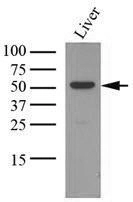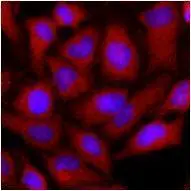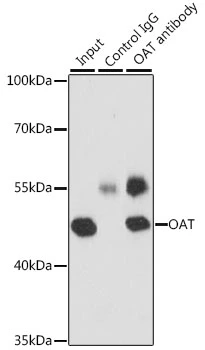
Tissue lysates of mouse liver (35ug) were resolved by SDS-PAGE, transferred to NC membrane and probed with anti-human OAT (1:1000). Proteins were visualized using a goat anti-mouse secondary antibody conjugated to HRP and an ECL detection system.
OAT antibody [AT23A2]
GTX50004
ApplicationsFlow Cytometry, ImmunoFluorescence, Western Blot, ELISA, ImmunoCytoChemistry
Product group Antibodies
ReactivityHuman, Mouse
TargetOAT
Overview
- SupplierGeneTex
- Product NameOAT antibody [AT23A2]
- Delivery Days Customer9
- ApplicationsFlow Cytometry, ImmunoFluorescence, Western Blot, ELISA, ImmunoCytoChemistry
- CertificationResearch Use Only
- ClonalityMonoclonal
- Clone IDAT23A2
- Concentration1 mg/ml
- ConjugateUnconjugated
- Gene ID4942
- Target nameOAT
- Target descriptionornithine aminotransferase
- Target synonymsGACR, HOGA, OATASE, OKT, ornithine aminotransferase, mitochondrial, gyrate atrophy, ornithine delta-aminotransferase, ornithine-oxo-acid aminotransferase, testicular tissue protein Li 130
- HostMouse
- IsotypeIgG1
- Protein IDP04181
- Protein NameOrnithine aminotransferase, mitochondrial
- Scientific DescriptionThis gene encodes the mitochondrial enzyme ornithine aminotransferase, which is a key enzyme in the pathway that converts arginine and ornithine into the major excitatory and inhibitory neurotransmitters glutamate and GABA. Mutations that result in a deficiency of this enzyme cause the autosomal recessive eye disease Gyrate Atrophy. Alternatively spliced transcript variants encoding different isoforms have been described. Related pseudogenes have been defined on the X chromosome. [provided by RefSeq, Jan 2010]
- ReactivityHuman, Mouse
- Storage Instruction-20°C or -80°C,2°C to 8°C
- UNSPSC12352203



